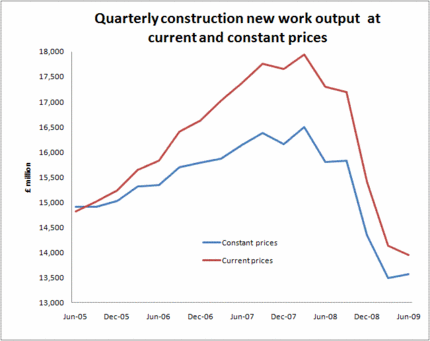Output figures show continued fall in cash flowing into construction
At first sight the latest construction output figures provide some relief. The fall in output in the second quarter of the year estimated to be just 0.5% and there was a slight rise in the output of new work measured in constant prices.
But then it is always worth taking a second look at anything in construction. I was warned as a young journalist: “Nothing in construction is ever quite what it seems.”
So I looked away from the “manipulated” constant price figures and took a butcher’s at the slightly less processed current price data. The logic here was that during a recession the amount of cash coming in is more important that the amount of work being done.
Well I am sorry to say chaps the news is not so good. There was a further fall of 1.7% compared with the first quarter. In cash terms that comes to £448 million, or enough to buy a pretty useful football stadium.
Looking just at the new work sector, there was a fall of 1.2% in the collective cash coming into the coffers of construction firms.

I have drawn a simple graph that illustrates the difference between new work measured in constant and current prices, which I hope illustrates the point.
As you can see work in the second quarter of 2009 was being completed at prices pretty close to those prices achieved in the second quarter of 2005.
I sniffed around the figures a bit more to see what coefficients the statisticians might be using to “correct” the cash figures and to convert them into volume figures, or constant price figures, if you like.
Certainly, construction work appears to be coming in at a much lower cost to the client. This is excellent news if it means we are seeing productivity gains. But I don’t think it is that simple.
Anyway, here’s a crude list of how I reckon costs have, in the eyes of the statisticians, fallen peak:
- Public housing: 6.7%
- Private housing: 12.9%
- Infrastructure: 13.2%
- Public non-housing: 12.8%
- Industrial: 1.2%
- RMI:1%
The figures suggest that commercial work prices continued to rise in the second quarter.
Naturally we can question the statistical alchemy that turns a fall in new work output measured at current prices into a rise in constant prices. But more importantly the message to me is that we should be wary of how we interpret these data.
So I was rather surprised, no startled, to see the RICS take on the numbers.
The interpretation by Simon Rubinsohn, chief economist at RICS, was exceptionally bullish in my view.
He says: “While it would be misguided to interpret the latest data as signalling that the pain is over in the construction sector, the worst of the adjustment does now appear to lie in the past and the more probable scenario going forward is one of a very gradual recovery against a backdrop of a continued shortfall of development finance.”
My own view fits more with the take offered by the Construction Products Association.
Expressed by Michael Ankers, chief executive, it is: “With the construction industry experiencing its sharpest decline in output since the War, it is more important than ever that Government maintains its capital investment programme to improve our transport infrastructure, education facilities and social housing.”
And the comfort blanket that public spending is providing should not be exaggerated. If public non-housing new work had falling at the same rate as the rest of the new work in construction we would have seen a 24% annual decline instead of the 19% fall in the cash coming into construction in the second quarter.
Put in cash terms that is £1 billion less spent on construction in one quarter.
And when this support is pulled what then?
I suspect we are a long way from seeing a turnaround in the fortunes of construction and rather than supporting the green shoots position, these latest figures rather shoot it down.
By way of an addendum, one other thing that I thought worth noteworthy, as I scratched through the figures, was the imbalance of pain suffered regionally.
This may surprise some in the metropolitan South East, but the construction industry in London continued to grow in cash terms up to last autumn. This is partly down to the overhang of work in progress as a result of the larger projects found in the capital.
Indeed the work completed in the 12 months to June in London was only marginally down in cash terms on the previous quarter and just 3% down from peak. This compares with a 17% drop in Yorkshire & Humberside, 15% in the West Midland and in Wales, 13% in the North West and 12% in the East Midlands.
What we are seeing is a north south split in terms of how this has impacted on the cash won by contractors.